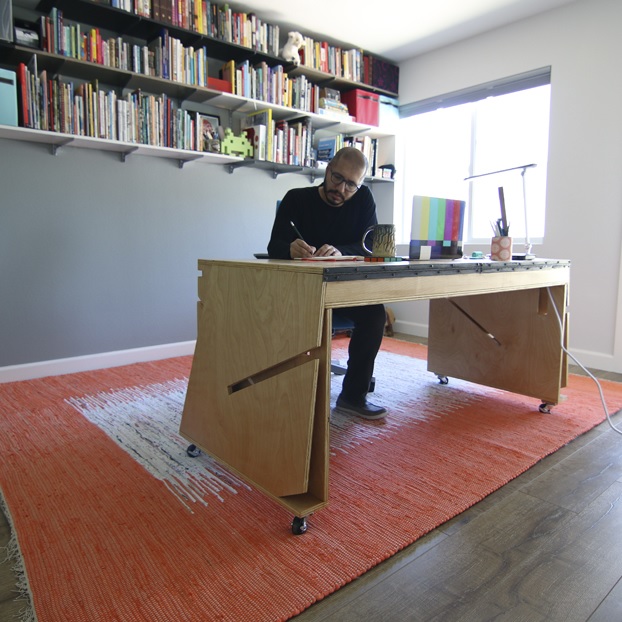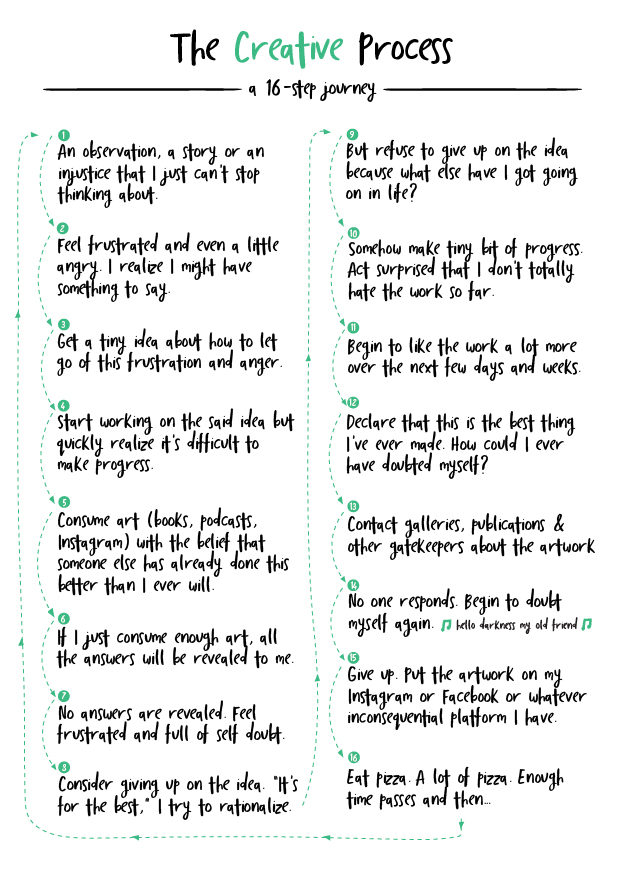
The latest art by Safwat Saleem, “Concerned, but Powerless,” responds to the current national and political climate with a series of visuals that combine retro-style images, English and Urdu text, and satire. Saleem is a Pakistani-American visual artist, graphic designer, filmmaker and TED Senior Fellow. His work for “Concerned, but Powerless” exhibited at the Vision Gallery in Chandler, Arizona, Jan. 16-March 2. Saleem’s past work includes a number of projects, such as “A Bunch of Crock,” an art exhibit about the absurdity of political campaigns, “What to Do When Nothing Makes Sense” — an essay written and illustrated after the 2015 Paris attacks, and “Cool Clock, Ahmed” — an interactive art installation described as “an attempt to help us get over our fear of clocks.”
In a video called “Cheaper Than Therapy,” Saleem talks about how he works, what it’s like being an artist in Phoenix, and some of his past projects. He says, “art is a very cathartic experience for me because it’s how I make sense of what’s happening in the world, of what is happening in my surroundings. It’s the act of processing something that might be beyond me, that I can’t immediately make sense of.” Saleem’s “Concerned, but Powerless” processes the 2016 Presidential election and its aftermath in a powerful and personal way, using seemingly nostalgic images in mixed media collages combined with dark political humor, serving to voice the frustrations and disappointments felt by many people after the election.
Take a look at ten pieces by Safwat Saleem from “Concerned, but Powerless” below (plus a rough Urdu to English translation guide). Keep scrolling down after that to read a Q&A with the artist. Saleem took time to share thoughts about his creative process (creating a flowchart to illustrate it, actually), his use of Urdu in the pieces, and how becoming a U.S. citizen and becoming a parent affected his work.
***
Here is Saleem’s artist’s statement on the exhibit of “Concerned, but Powerless”:
The work began in early 2016 as a way for me to process the ongoing presidential election. I had planned to conclude the series on election day, but the outcome of the election and events since then have implored me to continue the work. Over time, the series has become increasingly desperate.
***
What compelled you to become an artist?
I like that you use the word “compelled.” Looking back, it does feel like something I absolutely had to do, but it’s been a long and slow process to get here. I started making art about nine years ago. At the time, it was a result of having something to say but no other platform to convey it. And most of the art I’ve made since then has been the result of having something to say. Perhaps that is why my artwork consists of so much written word because I tend to use the art as an extension of my voice. I wonder if I was actually supposed to be a writer? But making visual art is a lot easier than writing, so here we are.
What’s the most challenging part of being an artist?
Almost everything about being an artist — a desi artist at that — is a challenge in itself. The list of challenges is long and includes things like trying to make a living through art and getting past the gatekeepers of the art world — although, these days the biggest challenge is finding enough time to make new art. As I get older, it’s becoming increasingly difficult to pull all-nighters, and my art is something I’ve always done in addition to working as a full-time graphic designer. Also, I’m pretty sure my parents still feel it’s not too late for me to finally see the light and get into medical school.
What is your creative process like?
Let me draw out my creative process for you.

Did you start the work in “Concerned but Powerless” before the 2016 election results? How did your work on it change or become affected by the election results?
In early 2016, when the primaries were around the corner, I felt dismayed about the candidates running for office. I didn’t feel like any of the candidates cared about people like me, and so I began to jot down my thoughts about the electoral process as they came to me. At the time I didn’t have a plan to turn these random scribblings into a series, but as the election got into full swing and the rhetoric got increasingly anti-immigrant, I began to turn the writings into visual art.
I had planned to conclude the series on election day, but the outcome of the election and events since then implored me to continue the work. To me, there is marked difference in the what I made before and after the election. While the entire series is darkly humorous, the pieces made after the election are especially devoid of hope and have a sense of desperation about them.
How does the Urdu text used in your work connect (or not) to the English text being used in the same pieces?
The Urdu text you see made its way into the series quite late. I was done with over half the series when I felt the urge to go back in and add Urdu typography. While working on this series, I became a parent, and it made me think a lot about language. My daughter will know America as her only home, making me wonder about the kind of relationship she will have with my place of birth — Pakistan. This past year I also went through the naturalization process to become an American citizen. Both these events made me feel like Urdu might be a lost language in my family moving forward, and the culture I grew up with might no longer be a part of my daughter’s life. So, using Urdu in this series was an attempt to preserve a little bit of my origin story.
Which change has had more of an impact on your work — becoming a US citizen or becoming a parent? Why?
Both are profound experiences that have completely altered my worldview. Becoming a U.S. citizen felt more empowering than I ever thought it would. After the 2016 election, I felt lost and unsure about my place in the U.S. But when I went through the naturalization swearing in ceremony, I left feeling more hopeful than I had in a long time. There was a moment during the naturalization ceremony where they played a video of the U.S. president congratulating all of the new citizens. He reminded us what an honor this was and how we, as citizens, now had responsibilities toward the U.S. And I remember thinking with great pride that America was my home now and that I have the responsibility to vote this man out of the White House.
Becoming a parent has already had a huge impact on my work. I’m constantly thinking about the idea of belonging and how I can make sure that my daughter never feels she does not belong here. I challenge myself to create a world where she could feel completely at ease with her Pakistani and American heritage.
Which one of your creative works is your favorite so far?
My most recent work is usually my favorite. I have a hard time appreciating older work because I want to constantly improve it. But the series called “A Bunch of Crock” has a special place in my heart. It was my first overtly political project, and it felt wonderful to be able to work on it. It was a cathartic experience to turn my frustrations into art and then share them with the world as a way to feel less burdened.
Part of your exhibit invites people to interact by writing on cards about what makes them feel concerned and powerless. What kind of responses have caught your interest?
This was a last-minute idea that turned into my favorite part of the exhibit. I received hundreds of responses, and there were many that I thought about long after. There was this one particular card written by a 15-year-old that said “Will I get shot at school” and I think about that one quite often.
Looking at the responses as whole, a few themes began to emerge. Many people seem concerned about the direction of the country and the impact that hostile political rhetoric is having on our kids. I shared some of the responses on my Instagram page here and here.
Visit Safwat Saleem’s website for more on his work, and find him on Twitter and Instagram.
***
All images in this post provided by Safwat Saleem.
Pavani Yalamanchili is an editor at The Aerogram. Find her on Twitter at @_pavani, and follow The Aerogram at @theaerogram or on Facebook.























